Interview with Mizuho Nishikubo (1)
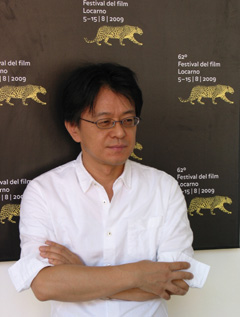 | Mizuho Nishikubo Born in Tokyo on January 15, 1953, Nishikubo is a longtime and most trusted collaborator of Mamoru Oshii, and has participated as sequence director (but under his real name of Toshihiko Nishikubo) in all Oshii's works since Patlabor 2: The Movie (1993), namely Ghost in the Shell, Cannes Palme d'Or-nominated Innocence and Golden Lion-nominated The Sky Crawlers. It is said that Oshii's movies would not look the same without his contribution. He uses his alias Mizuho Nishikubo when he directs. After graduating from Waseda University, Nishikubo joined Tatsunoko Production in 1975, and in 1979 became a protégé of Osamu Dezaki, one of Japan's most respected animation directors. His collaborations with Dezaki include TV series Lady Oscar (1979) and Ashita no Jo 2 (1980). Nishikubo made his directorial debut in 1983 with Mitsuru Adachi's romantic comedy Miyuki (1983, TV series). Other credits include Red Photon Zillion, (1987, TV series) Legend of Heavenly Sphere Shurato (1989, TV series), Video Girl Ai (1992, OVA) and Otogi Zoshi (2004, TV series). He also directed the music clip Tsepi i kol'tsa / Chains & Rings (2003) for the hugely popular Russian rock star Linda. His movie, Musashi: The Dream of the Last Samurai screened in Locarno, Sitges, Warsaw and Stockholm |
Part 1
Can you tell us about how this project started and how you came to be involved? What did you discuss with Mamoru Oshii?
The starting point was this idea of making an animated movie in documentary style. I had a meeting with Oshii and he suddenly said, "How about Musashi?" However, when I heard the name, I felt a bit concerned, because this historical character is so popular that he has been featured in all possible ways and media in dozens -if not hundreds- of books, movies, TV shows, comics and anime. I thought that it was an exhausted theme. What could we add that it had not been said yet? But Oshii had a very clear vision, and explained that "horses" was the keyword to a new approach for the understanding of Miyamoto Musashi. In fact, so far nobody had analyzed the role of horses in Musashi's vision of -or obsession for- the art of war. Then Oshii said that he wanted to take care of the script, and gave me freehand on directing this movie. The first two-page plot had a picture of WWII battleship Musashi on the cover!
From the swordsman to the battleship... sounds as a commentary to the Japanese spirit. Could you tell us more about Oshii's script, and how you made it into this animated film in documentary style?
Mamoru Oshii's script encompassed an amazingly wide range of topics, from Achaemenid Persia to Han China, Macedonian war tactics, Sarmatian and Anglo-Saxon cavalry to the evolution of knights in Europe, and reached as far as the Russo-Japanese War and the appearance of tanks on the Western front during WWI, of course not without his sarcastic commentary on how Japanese tend to identify modernization with the removal of their cultural heritage. So my challenge was about how to make this profoundly erudite excursus on Musashi entertaining.

I can say that the point of this movie is the contrast between Oshii-style lecture and fast-paced sword action drama. I wanted this contrast to appear as vivid as possible. So I decided to render the lecture parts by mixing different techniques -basically 3D animation and live-action footage- while the drama parts are in traditional 2D animation. Besides, for the lecture parts I used a variety of languages such as narration, real and fabricated objects and documents, archive stills, 3D simulations and scientific demonstrations. Exactly what you would expect from a traditional live-action documentary. We actually visited the sites of Sekigahara and Ganryujima (*) and shot footage in loco to be incorporated in the movie.
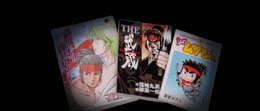
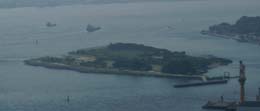
Can you explain more about the different visual styles used in this movie?
Since emphasizing the gap between documentary-style lecture and dramatic action was one of the themes of this movie, we decided to render the first in a funny and lovable style, and the latter with a very realistic design. For this purpose, Kazuto Nakazawa designed for us really cool swordsmen, while the movie's colour designer Kumiko Yusa gave shape to this loquacious self-professed Musashi expert called Kiichi Inukai, who looks like an old professor, but he's also kind of cute. Yusa-san designed Inukai with an aged Musashi in mind as reference. However, when we saw the designs, everybody in the studio immediately thought that he strikingly resembled Oshii himself. So you can see him as Musashi in his late years, or Mamoru Oshii's alter ego. I leave this decision up to you.
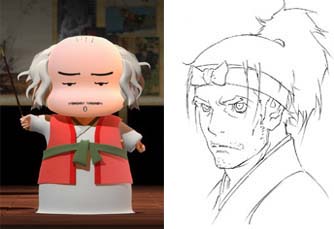
How about the sword fight sequences, made in 2D animation?
Actually they were not in the original Oshii's script. Adding them was my decision. I asked Nakazawa-san some realistic designs. But then I had to face the problem of gathering staff skilled enough to animate those astounding characters Nakazawa-san designed for us. I also needed animators skilled at drawing horses, the main theme of the film. Depiction of horses in animation is never an easy task, and you have to select the right people if you want the job to be done properly. I personally selected the key animators one by one. Fortunately we could rely on Kazuchika Kise, one of the best horse animators in Japan. I had already worked with him in Otogi Zoshi and I knew what I could get from the man. He redrew my storyboards, giving each scene exactly the layout I was looking for. He also did a great job with kimonos, another hard-to-animate item, as you have to calculate the body movement under a very thick robe.
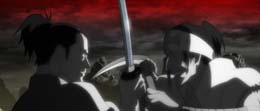
Did you do any research for the duels?
Initially, for the animation I wanted something really stylish, something playing to the gallery with all cool poses and sword-wielding you see in samurai action movies. However, Kise-san disagreed and said he wanted a realistic rendering in the characters' movements, too. When a samurai unsheathed his sword, he was very likely to try to strike fast and effectively. If a swordsman had acted the way you see in the movies, he would have probably been killed at once. So the staff watched several videos about Japanese-style fencing in order to be as faithful as possible to actual sword fighting, and we used the cool but unrealistic style only in the Shishido duel sequence, because Shishido is a fictional character. In the end, the 2D sequences alone took eight months of work.
(*) The sites of the first battle Musashi took part in, and of the legendary duel with Sasaki Kojiro, respectively.
(1 - to be continued)
© 2009 Production I.G / Musashi Production Committee

![WORK LIST[DETAILS]](/contents/works/design/images/left_title.gif)



 terms of use
terms of use